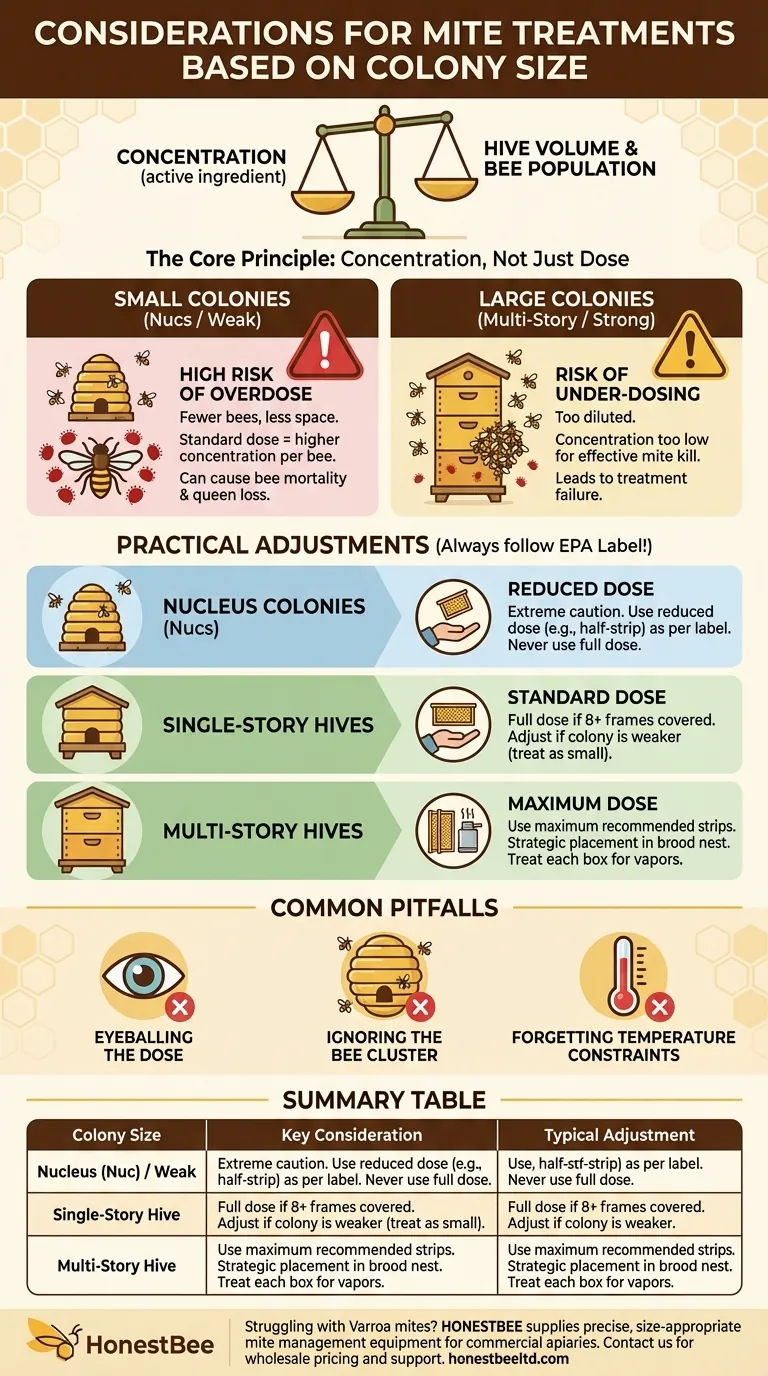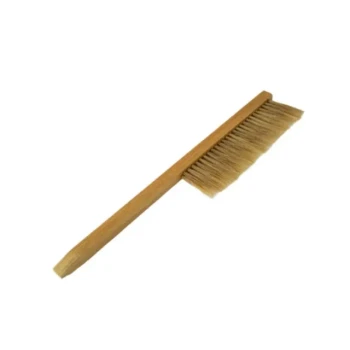Ultimately, colony size is a critical factor in determining the correct mite treatment dosage for both safety and effectiveness. Applying a standard dose to a small colony can lead to overdose, harming or killing the bees and queen, while applying that same dose to a massive colony can be ineffective, allowing mite populations to survive and rebound. The key is to match the treatment to the colony's actual population and volume.
The core principle of mite treatment is not about the absolute dose you apply, but about achieving the correct concentration of the active ingredient within the hive's specific volume and bee population.

The Core Principle: Concentration, Not Just Dose
Understanding why colony size matters requires thinking about treatment concentration. A successful treatment must make the hive environment lethal to mites but safe for bees. This balance is directly tied to colony size.
Why Small Colonies Are at High Risk
A small or weak colony, such as a nucleus hive (nuc) or a recently established swarm, has fewer bees and occupies less physical space.
Applying a standard treatment strip or vapor dose to this small population results in a much higher concentration of the active ingredient per bee. This can quickly lead to an overdose, causing bee mortality, queen damage or rejection, and brood loss.
The Challenge of Large, Strong Colonies
Conversely, a large, thriving colony in two or more hive bodies presents the opposite challenge: under-dosing.
If you use a dose intended for a smaller, single-story hive, the treatment will be too diluted to be effective. The concentration of the active ingredient will be too low to kill a sufficient percentage of mites, leading to treatment failure and a false sense of security.
Brood Volume vs. Bee Population
"Colony size" refers to two interconnected factors: the number of adult bees (the bee cluster) and the volume of the hive they occupy.
Some treatments, like formic acid, are vapor-based and need to fill the entire hive volume at a specific concentration. Other treatments, like strip-based miticides, work via contact and must be placed where bees will consistently interact with them. Always assess the size of the bee cluster, not just the number of boxes.
Practical Adjustments for Different Hive Sizes
Always read and follow the EPA label for any treatment, as it is the legal and scientific guide. Labels often provide specific instructions or ranges based on colony size.
Treating Nucleus Colonies (Nucs)
Exercise extreme caution with nucs and very weak colonies. Many labels will specify a reduced dose, such as using a half-strip of a product like Apivar instead of a full one.
Never use a full dose intended for a large hive in a nuc unless the label explicitly permits it. The risk of poisoning the colony is simply too high.
Treating Single-Story Hives
A full, single-story hive is often the "standard" size referenced on treatment labels. A brood box with 8 or more frames densely covered in bees is a typical example.
Even here, use judgment. If a single box is only half-full of bees, it should be treated as a weaker colony, and a dose reduction may be warranted according to the product label.
Treating Multi-Story Hives
Large colonies that occupy two or more hive bodies require a full, robust treatment plan to ensure the miticide reaches the entire population.
For strips, this means using the maximum number of recommended strips and placing them strategically in the heart of the brood nest, ensuring they span the areas with the most bee traffic. For vapors like oxalic acid, this may require treating each box individually to ensure proper distribution.
Understanding the Trade-offs and Pitfalls
Incorrectly dosing based on colony size is one of the most common reasons for treatment failure or colony damage.
The Danger of "Eyeballing" the Dose
Do not guess. The difference between an effective dose and a harmful one can be small. Reading and precisely following the label's instructions for different colony sizes is not optional; it is essential for success.
Ignoring the Bee Cluster
A common mistake is treating based on the size of the equipment, not the size of the bee population. A weak colony in a large, double-deep hive is still a weak colony. The dose should be based on the small cluster of bees, not the large empty space.
Forgetting Temperature Constraints
Many treatments, especially vapor and gel formulations like formic acid, have strict temperature requirements. The internal temperature of a small, weak colony is more volatile. Applying a temperature-sensitive treatment during a heatwave can be catastrophic, especially for a small colony that cannot adequately regulate the internal hive temperature.
Making the Right Choice for Your Colony
Your goal is to apply the correct, label-approved treatment for the actual number of bees in your hive.
- If your primary focus is a nucleus colony or a very weak hive: Prioritize safety by carefully reading the label for instructions on reduced doses or using products specifically approved for smaller populations.
- If your primary focus is a standard, single-story colony: Follow the label instructions precisely, but first, confirm the colony is strong enough (e.g., covering at least 7-8 frames) to be considered "standard."
- If your primary focus is a large, multi-story hive: Ensure you use the full, recommended dose and proper placement to guarantee the treatment is distributed throughout the entire bee cluster and is effective.
Properly adapting your mite treatment to each colony's unique size is a hallmark of responsible and successful beekeeping.
Summary Table:
| Colony Size | Key Consideration | Typical Adjustment |
|---|---|---|
| Nucleus (Nuc) / Weak | High risk of overdose | Use half-strip or reduced dose per label |
| Single-Story Hive | Standard reference size | Apply full dose if 8+ frames covered |
| Multi-Story Hive | Risk of under-dosing | Use maximum strips, treat each box for vapors |
Struggling with Varroa mites? Proper treatment is key to colony health. At HONESTBEE, we supply commercial apiaries and distributors with the precise equipment and supplies needed for effective, size-appropriate mite management. Let our experts help you select the right treatments for your operation. Contact HONESTBEE today for wholesale pricing and tailored support.
Visual Guide

Related Products
- Adjustable Formic and Acetic Acid Dispenser for Bee Mite Treatment
- Professional Bamboo Queen Isolation Cage
- Wooden Bee Brush with Triple Row Artificial Fiber for Beekeeping
- Langstroth Screen Bottom Board for Beekeeping Wholesale
- Classic Wooden Bee Brush with Double-Row Boar Bristles
People Also Ask
- What are phoretic mites? A Beekeeper's Guide to Monitoring Varroa Infestation
- What is the focus of hive management during summer? Maximize Your Honey Harvest with Expert Tips
- What does Chewed Down Brood (CDB) indicate in bee colonies? A Sign of Varroa Mite Infestation
- How do Varroa mites spread between honey bee colonies? Stop Mite Transmission in Your Apiary
- What should be done after treating a colony for varroa mites? A Step-by-Step Guide to Verifying Success



















